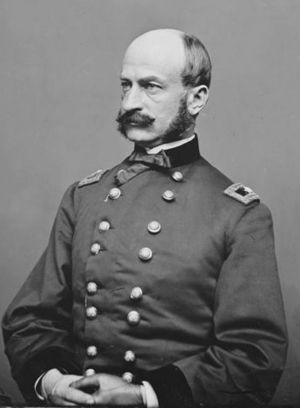Adolph von Steinwehr facts for kids
Quick facts for kids
Adolph von Steinwehr
|
|
|---|---|

Adolph von Steinwehr
|
|
| Born | September 22, 1822 Blankenburg, Brunswick, Germany |
| Died | February 25, 1877 (aged 54) Buffalo, New York |
| Place of burial |
Albany Rural Cemetery, Menands, New York
|
| Allegiance | Brunswick United States of America |
| Service/ |
Brunswick Army United States Army Union Army |
| Years of service | 1841–1847 1861–1865 |
| Rank | Lieutenant (Brunswick) |
| Unit | Army of the Potomac Army of the Cumberland |
| Commands held | von Steinwehr's Brigade, XI Corps |
| Battles/wars | American Civil War |
| Other work | geographer, cartographer, author |
Baron Adolph Wilhelm August Friedrich von Steinwehr (born September 25, 1822 – died February 25, 1877) was a German army officer. He moved to the United States and became a geographer (someone who studies the Earth's features), a cartographer (someone who makes maps), and an author. During the American Civil War, he served as a general for the Union Army.
Contents
Early Life and Work
Adolph von Steinwehr was born in Blankenburg, Germany. His family had a long history of military service. His grandfather was a general in the Prussian Army.
Adolph went to the Brunswick Military Academy. In 1841, he became a lieutenant in the Brunswick Army. Six years later, in 1847, he left the army and moved to the United States. He settled in Alabama.
He worked as an engineer for the U.S. Coast Survey. His job was to map areas like the U.S.-Mexico border and Mobile Bay, Alabama. He wanted to fight in the Mexican–American War, but he wasn't allowed to.
In 1849, he went back to Brunswick. Before leaving, he married Florence Mary from Mobile, Alabama. He returned to the United States in 1854. He bought a farm in Wallingford, Connecticut, and later moved to New York State.
Civil War Service
When the American Civil War began, Steinwehr helped create a new army unit. This unit, called the 29th New York Volunteer Infantry Regiment, was mostly made up of German immigrants. He led this regiment at the First Battle of Bull Run. His unit helped protect the Union soldiers as they retreated.
On October 12, 1861, he was promoted to brigadier general. He then commanded a brigade (a large group of soldiers) in the Army of the Potomac. His brigade later joined Maj. Gen. John C. Frémont's Mountain Department. They fought in the Valley Campaign against Maj. Gen. Stonewall Jackson.
Steinwehr was given command of the 2nd Division in the XI Corps. This corps was part of the Army of Virginia. They took part in the Northern Virginia Campaign. However, they did not play a big role in the Second Battle of Bull Run. His division also did not fight in the Battle of Antietam or the Battle of Fredericksburg.
Challenges of the XI Corps
In 1863, Maj. Gen. Oliver O. Howard took command of the XI Corps. Steinwehr continued to lead his division in the Battle of Chancellorsville and the Battle of Gettysburg.
At Chancellorsville, on May 2, 1863, Stonewall Jackson launched a surprise attack. Steinwehr's division, specifically a brigade led by Col. Adolphus Buschbeck, helped resist this attack.
At Gettysburg, on July 1, 1863, the XI Corps faced a strong attack. They were forced to retreat through the town. Col. Charles Coster, leading a brigade from Steinwehr's division, bravely fought to buy time for the other soldiers to escape.
These battles were very difficult for the XI Corps. Despite the challenges, Steinwehr was respected by his leaders. After Chancellorsville, General Howard said Steinwehr was "cool, collected and judicious" during the battle. Another general, Alpheus Williams, called him a "remarkably intelligent and agreeable person."
Transfer to the Western Theater
In September 1863, two divisions from the XI Corps, including Steinwehr's, were moved to the Western Theater. This was to help the Union army that was surrounded in Chattanooga. They became part of the Army of the Cumberland.
They fought under Maj. Gen. Joseph Hooker in the Battle of Wauhatchie. A brigade from Steinwehr's division, led by Col. Orland Smith, fought very well there. Buschbeck's brigade also fought alongside Maj. Gen. William T. Sherman at the Third Battle of Chattanooga.
After this battle, the XI Corps was combined with another corps to form the new XX Corps. Steinwehr no longer commanded a combat unit. He resigned from the army on July 3, 1865, after the war ended.
Life After the War
After the Civil War, Adolph von Steinwehr continued his work as a geographer and cartographer. He returned to Connecticut and became a professor at Yale University.
He later lived in Washington, D.C., Ohio, and then returned to New York. He passed away in Buffalo, New York, on February 25, 1877. He is buried in Albany Rural Cemetery, New York.
Steinwehr was a busy author. He wrote several books about geography, including:
- A School Geography: Embracing a Mathematical, Physical, and Political Descriptions of the Earth (1870)
- Primary Geography (1870) (co-author)
- An Elementary Treatise on Physical Geography (1873) (co-author)
- The Centennial Gazetteer of the United States (1874) (editor)
Today, a street in Gettysburg, Pennsylvania, called Steinwehr Avenue, is named in his honor.
See also
- List of American Civil War generals (Union)
- German Americans in the Civil War

